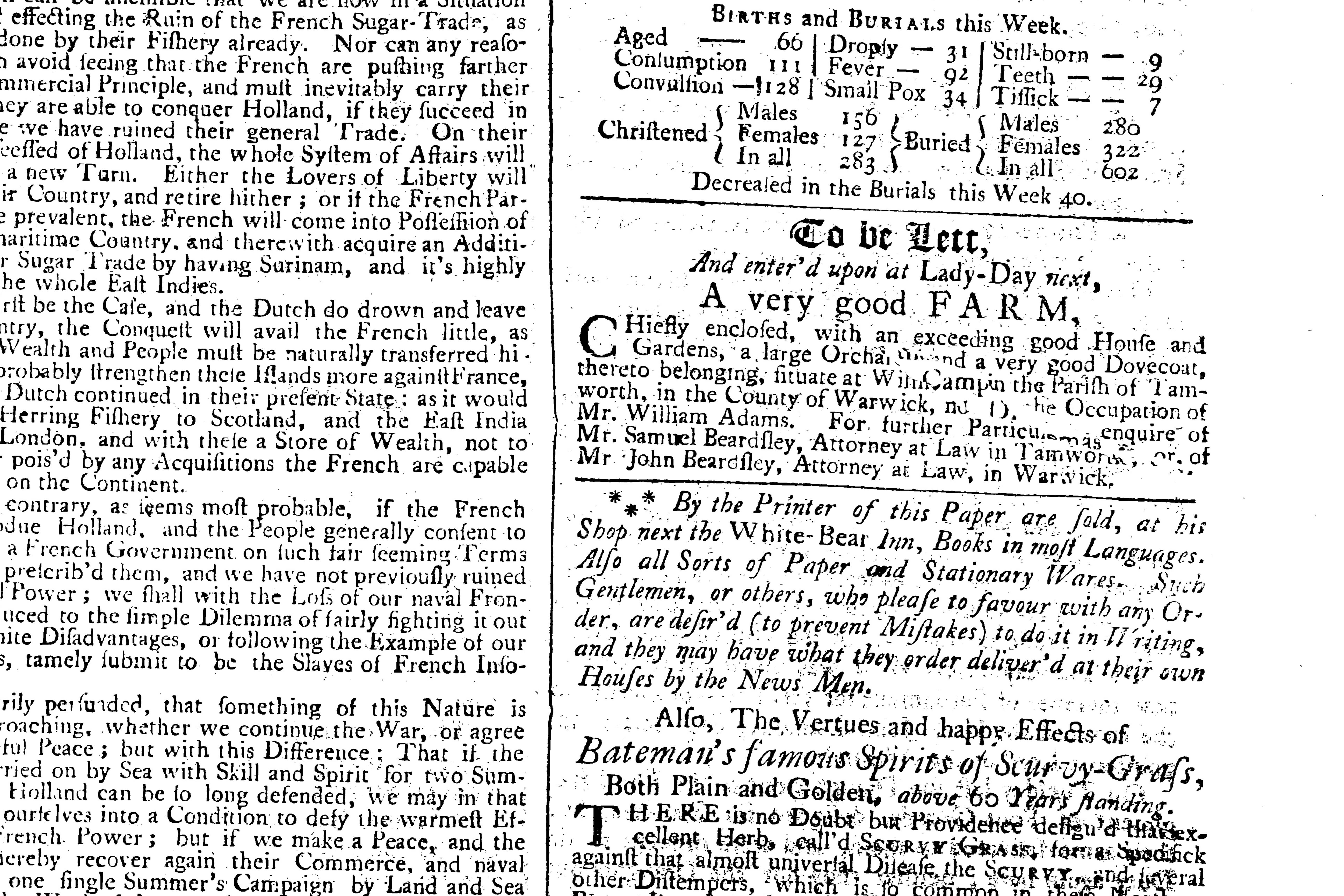Tales from the Archives: Jopson's Coventry Mercury
25 July 2019
The weekly journal known as Jopson’s Coventry Mercury, commenced in 1741 and was undoubtedly one of the best produced provincial journals of the time.
The first number was published on 20 July 1741 and is unfortunately no longer available locally, but it was reportedly of small size; foolscap folio, four pages, with three columns on a page and bore a halfpenny stamp. . the name in full was the “Coventry Mercury, or the Weekly Coventry Journal”, and the price was twopence.
Early issues of this publication are unfortunately missing, and information on Mr.Jopson himself is very scarce, but it can be seen from a featured edition, the earliest one in our archives, that he must have been a very busy man.

Despite its’ local title the newspaper focussed mainly on national and international news… There were of course some local notices and advertisements, but ….. ‘More than half of the first number of the Coventry Mercury is taken up with foreign intelligence. There is not in it a single paragraph of purely local interest, nor any record of births, deaths or marriages’….
any record of births, deaths or marriages’….
The first issue of the Mercury was contemporaneous with great events. Walpole was in political straits; England and Spain were at war, and Admiral Vernon was repulsed at Carthagena,, and this situation was reflected in a performance report in the Mercury of 5 March 1759, recording War“ Expeditions since the beginning of the Spanish War
1739, to the First Jan 1759”; giving details and results of some twenty one expeditions during that period. Another example of his national interests are provided by this example from this same early edition, the item listed as “Wednesday’s Post” and dated Amsterdam Feb. 27.
Two centuries ago a newspaper would be considered up to date in many districts if it reached its readers within a month or six weeks of publication, and even then there would be a waiting period as the newssheet was passed from hand to hand when a single copy often served the requirements of half a village, and the distribution of the paper was carried out (as the imprint states) by men who went out all over the Midland Counties with the papers and are known to have circulated as far as Rutlandshire and South Yorkshire.
This may account for the frequently changing name of the publication: the full name on its release was replaced by Jopson’s Coventry and Northampton Mercury, or the Weekly Country Journal on 23 February 1743, but on 6 July in the same year it again became Jopson’s Coventry Mercury or the Weekly Country Journal, and in 1757 the Mercury was enlarged to a crown folio.
On Mr.Jopson’s death in 1759 the publication to the Mercury fell into the hands of his widow who continued the proprietorship for several years until it was purchased by a company of Coventry gentleman who in turn, in 1780, disposed of it to a Mr Richard Bird, and on his death, into the hands of Mr. Noah Rollason who again changed the title, this time to “Coventry Mercury, and the Warwickshire, Northamptonshire, Leicestershire and Oxfordshire general Advertiser”
This may account for the frequently changing name of the publication: the full name on its release was replaced by Jopson’s Coventry and Northampton Mercury, or the Weekly Country Journal on 23 February 1743, but on 6 July in the same year it again became Jopson’s Coventry Mercury or the Weekly Country Journal, and in 1757 the Mercury was enlarged to a crown folio.
On Mr.Jopson’s death in 1759 the publication to the Mercury fell into the hands of his widow who continued the proprietorship for several years until it was purchased by a company of Coventry gentleman who in turn, in 1780, disposed of it to a Mr Richard Bird, and on his death, into the hands of Mr. Noah Rollason who again changed the title, this time to “Coventry Mercury, and the Warwickshire, Northamptonshire, Leicestershire and Oxfordshire general Advertiser”
The Mercury, was from the outset a “Church and King paper”, and continued to be the organ of the Conservative party and on the appearance of a new rival, its size was increased to a crown sheet with five columns leading to the installation of a new press and a partnership with Mr. William Reader who continued to conduct the “Mercury” business under a partnership with the widow of Mr. Rollason, on his death in 1813, until his own retirement in 1833 when it was published by Mr Charles Aris Noah Rollason, he having succeeded to the business, (The Coventry Herald was established in 1808 chiefly to present the dissenting interest in matters of religion, and the Whig interests politically)
Mr. Jopson’s editorial interests in national and international issues, were clearly maintained throughout the development of the newspaper, a tradition that was clearly manifested in the edition of 2 Dec 1805 when the front page was almost completely occupied by a comprehensive description of the Battle of Trafalgar, some six weeks earlier, with painstaking details cataloguing the vessels engaged, their weaponry and crew, and the casualties incurred.
The new proprietorship and management did not, however, give satisfaction to the Conservative party, some leading members of which issued a prospectus of a new paper to be called the “Coventry Standard and Warwickshire Advertiser”. In consequence of this, Mr Rollason, finding his supporters drifting away from him, disposed of his interest in the Mercury to the new company and in 1836 the name Mercury was dropped and the “Coventry Standard” took the place of the old journal.
Coventry Archives holds large numbers of the copies of the Mercury and Standard, and microfilm copies are available for viewing in our Reading Room, open 10:30 to 15:30 Wednesday to Friday each week and alternate Saturdays at the same times.
Sources; Coventry Mercury; Coventry Standard; Poole; Humberstone.